会计学-企业决策的基础 答案
会计学-企业决策的基础 问题详解
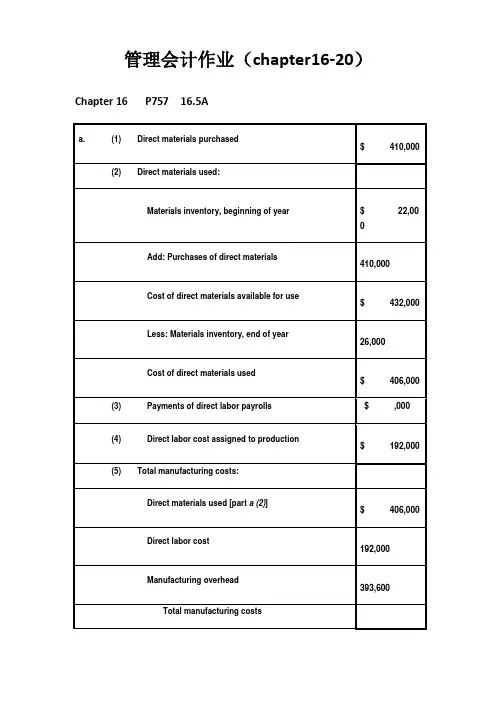
管理会计作业(chapter16-20)Chapter 16 P757 16.5AChapter 16 P761 16.4BChapter 17 P802 17.3Aa. Department One overhead application rate based onmachine-hours:ManufacturingOverhead = $420,000 = $35 per machine-hour Machine-Hours 12,000Department Two overhead application rate based on direct labor hours:ManufacturingOverhead = $337,500 = $22.50 per direct laborhourDirect Labor Hours 15,000Chapter 17 P805 17.8Ad. The Custom Cuts product line is very labor intensive in comparison to the Basic Chunksproduct line. Thus, the company’s current practice of using direct labor hours toallocate overhead results in the assignment of a disproportionate amount of total overhead to the Custom Cuts product line. If pricing decisions are set as a fixed percentage above the manufacturing costs assigned to each product, the Custom Cuts product line isoverpriced in the marketplace whereas the Basic Chunks product line is currently priced at an artificially low price in the marketplace. This probably explains why sales of Basic Chunks remain strong while sales of Custom Cuts are on the decline.e. The benefits the company would achieve by implementing an activity-based costing systeminclude: (1) a better identification of its operating inefficiencies, (2) a better understanding of its overhead cost structure, (3) a better understanding of the resource requirements of each product line, (4) the potential to increase the selling price of Basic Chunks to make it more comparable to competitive brands and possibly do so without having to sacrificesignificant market share, and (5) the ability to decrease the selling price of Custom Cuts without having to sacrifice product quality.Chapter 18 P835 18.1B. Ex.18.1a. job costing (each project of a construction company is unique)b . both job and process costing (institutional clients may represent unique jobs)c. job costing (each set of equipment is uniquely designed andmanufactured)d . process costing (the dog houses are uniformly manufactured in high volumes)e. process costing (the vitamins and supplements are uniformlymanufactured in high volumes)Chapter 18 P841 18.3Aa4,000 EU $61.50 = $246,000 b4,000 EU $13.50 = $54,000Chapter 18 P845 18.2Ba. (1) $49 [($192,000 + $48,000 + $54,000) ÷ 6,000 units](2) $109 [($480,000 + $108,000 + $66,000) ÷ 6,000 units](3) $158 ($49 + $109)(4) $32 ($192,000 ÷ 6,000 units)(5) $18 ($108,000 ÷ 6,000 units)b. In evaluating the overall efficiency of the Engine Department, management wouldlook at the monthly per-unit cost incurred by that department, which is the cost of assembling and installing an engine ($109 in part a).Chapter 20 P918 20.1Ad. No. With a unit sales price of $94, the break-even sales volume in units is 54,000 units:Unit contribution margin = $94 - $84 variable costs = $10Break-even sales volume (in units) = $540,000$10= 54,000 unitsUnless Thermal Tent has the ability to manufacture 54,000 units (or lower fixed and/or variable costs), setting the unit sales price at $94 will not enable Thermal Tent to break even.Chapter 20 P918 20.2AChapter 20 P920 20.6ASales volume required to maintain current operating income:Sales Volume =Fixed Costs + Target OperatingIncomeUnit Contribution Margin=$390,000 + $350,000= $20,000 units$37。
会计学 企业决策的基础 财务会计分册 版 章答案
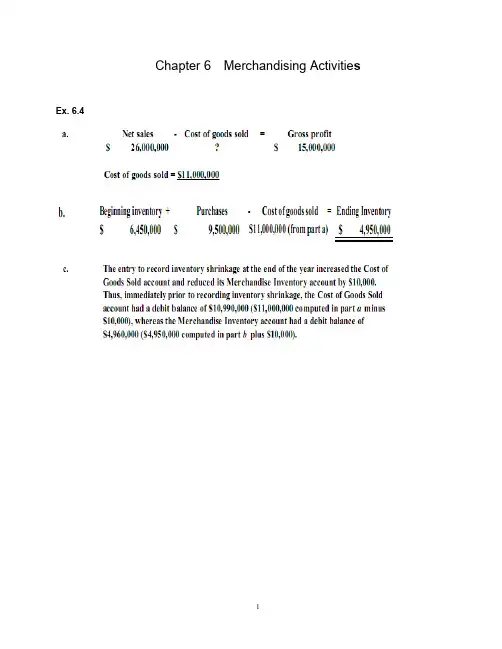
Chapter 6Merchandising Activitie s Ex. 6.41PROBLEM 6.1AClaypool earned a gross profit rate of 32%, which is significantly higher than the industry average. Claypool’s sales were above the industry average, and it earned $77,968 more gross profit than the “average” store of its size. This higher gross profit was earned even though its cost of goods sold was $18,000 to $20,000 higher than the industry average because of the additional transportation charges.To have a higher-than-average cost of goods sold and still earn a much larger-than-average amount of gross profit, Claypool must be able to charge substantially higher sales prices than most hardware stores. Presumably, the company could not charge such prices in a highly competitive environment. Thus, the remote location appears to insulate it from competition and allow it to operate more profitably than hardware stores with nearby competitors.PROBLEM 6.5Ac. Yes. Sole Mates should take advantage of 1/10, n/30 purchase discounts, even if itmust borrow money for a short period of time at an annual rate of 11%. Bytaking advantage of the discount, the company saves 1% by making payment 20 days early. At an interest rate of 11% per year, the bank charges only 0.6%interest over a 20-day period (11% X 20/365 = 0.6%). Thus, the cost of passing up the discount is greater than the cost of short-term borrowing.Chapter 7 Financial assetsChapter 8 Inventories and the cost of goods soldSupplementary ProblemChapter 91617。
会计学基础考试题及答案
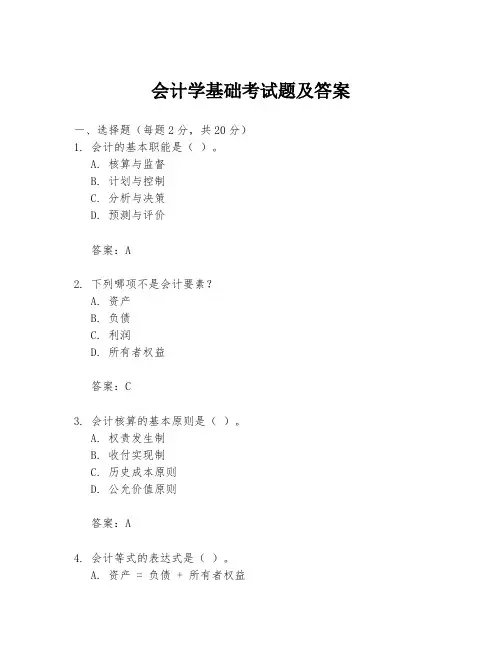
会计学基础考试题及答案一、选择题(每题2分,共20分)1. 会计的基本职能是()。
A. 核算与监督B. 计划与控制C. 分析与决策D. 预测与评价答案:A2. 下列哪项不是会计要素?A. 资产B. 负债C. 利润D. 所有者权益答案:C3. 会计核算的基本原则是()。
A. 权责发生制B. 收付实现制C. 历史成本原则D. 公允价值原则答案:A4. 会计等式的表达式是()。
A. 资产 = 负债 + 所有者权益B. 负债 = 资产 - 所有者权益C. 所有者权益 = 资产 - 负债D. 利润 = 收入 - 费用答案:A5. 会计信息的基本质量要求是()。
A. 可靠性B. 及时性C. 可比性D. 可理解性答案:A6. 下列哪项不是会计核算的基本前提?A. 会计主体B. 持续经营C. 货币计量D. 会计分期答案:B7. 会计报表中,反映企业财务状况的报表是()。
A. 利润表B. 资产负债表C. 现金流量表D. 所有者权益变动表答案:B8. 会计核算中,下列哪项属于流动资产?A. 固定资产B. 存货C. 长期投资D. 无形资产答案:B9. 会计核算中,下列哪项属于流动负债?A. 短期借款B. 长期借款C. 应付债券D. 长期应付款答案:A10. 会计核算中,下列哪项属于非货币性交易?A. 购买原材料B. 销售商品C. 以固定资产交换无形资产D. 支付工资答案:C二、判断题(每题1分,共10分)1. 会计核算的目的是提供财务信息,帮助各方做出经济决策。
()答案:√2. 会计要素包括资产、负债、所有者权益、收入和费用。
()答案:×(收入和费用是利润的组成部分,不是独立的会计要素)3. 会计分期是将企业持续经营的生产经营活动划分为相等的会计期间。
()答案:√4. 会计信息的可比性要求同一企业不同期间的会计信息应具有可比性。
()答案:√5. 会计核算中的权责发生制原则要求企业在收入和费用发生时进行确认。
会计学-企业决策的基础 答案教学资料
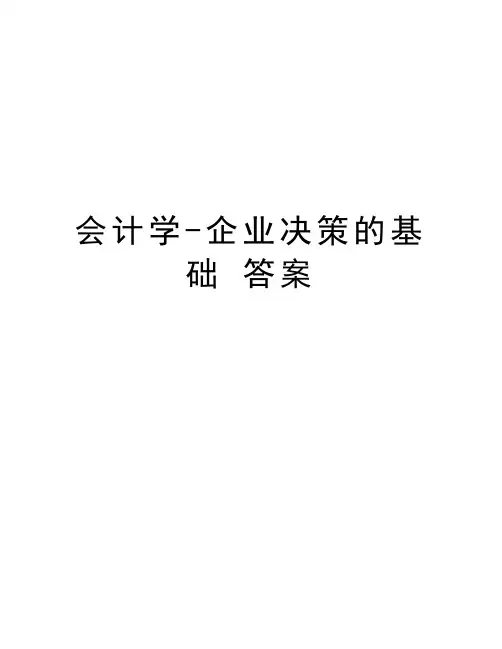
会计学-企业决策的基础答案管理会计作业(chapter16-20)Chapter 16 P757 16.5AChapter 16 P761 16.4BChapter 17 P802 17.3Aa. Department One overhead application rate based on machine-hours:Manufacturing Overhead= $420,000= $35 per machine-hourMachine-Hours 12,000Department Two overhead application rate based on direct labor hours:Manufacturing Overhead= $337,500= $22.50 per direct labor hourDirect Labor Hours 15,000Chapter 17 P805 17.8Ad. The Custom Cuts product line is very labor intensive in comparison to the BasicChunks product line. Thus, the company’s current practice of using direct laborhours to allocate overhead results in the assignment of a disproportionate amount of total overhead to the Custom Cuts product line. If pricing decisions are set as a fixed percentage above the manufacturing costs assigned to each product, the Custom Cuts product line is overpriced in the marketplace whereas the Basic Chunks product line is currently priced at an artificially low price in the marketplace. This probablyexplains why sales of Basic Chunks remain strong while sales of Custom Cuts are on the decline.e. The benefits the company would achieve by implementing an activity-based costingsystem include: (1) a better identification of its operating inefficiencies, (2) a betterunderstanding of its overhead cost structure, (3) a better understanding of theresource requirements of each product line, (4) the potential to increase the sellingprice of Basic Chunks to make it more comparable to competitive brands and possibly do so without having to sacrifice significant market share, and (5) the ability todecrease the selling price of Custom Cuts without having to sacrifice product quality.Chapter 18 P835 18.1a. job costing (each project of a construction company is unique)B. Ex.18.1b. both job and process costing (institutional clients may represent uniquejobs)c. job costing (each set of equipment is uniquely designed andmanufactured)d. process costing (the dog houses are uniformly manufactured in highvolumes)e. process costing (the vitamins and supplements are uniformlymanufactured in high volumes)Chapter 18 P841 18.3Ab4,000 EU @ $13.50 = $54,000Chapter 18 P845 18.2Ba. (1) $49 [($192,000 + $48,000 + $54,000) ÷ 6,000 units](2) $109 [($480,000 + $108,000 + $66,000) ÷ 6,000 units](3) $158 ($49 + $109)(4) $32 ($192,000 ÷ 6,000 units)(5) $18 ($108,000 ÷ 6,000 units)b. In evaluating the overall efficiency of the Engine Department, management wouldlook at the monthly per-unit cost incurred by that department, which is the cost of assembling and installing an engine ($109 in part a).Chapter 20 P918 20.1Ad. No. With a unit sales price of $94, the break-even sales volume in units is 54,000 units:Unit contribution margin = $94 - $84 variable costs = $10Break-even sales volume (in units) = $540,000$10= 54,000 unitsUnless Thermal Tent has the ability to manufacture 54,000 units (or lower fixed and/or variable costs), setting the unit sales price at $94 will not enable Thermal Tent to break even.Chapter 20 P918 20.2AChapter 20 P920 20.6ASales volume required to maintain current operating income:Sales Volume =Fixed Costs + Target Operating IncomeUnit Contribution Margin=$390,000 + $350,000= $20,000 units$37。
会计学基础试题及答案
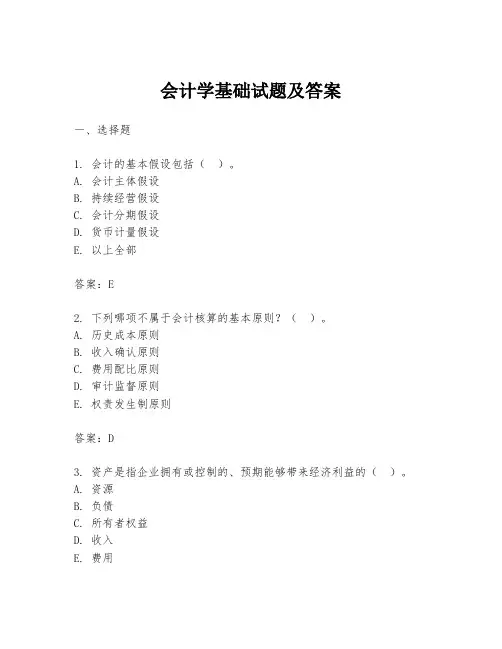
会计学基础试题及答案一、选择题1. 会计的基本假设包括()。
A. 会计主体假设B. 持续经营假设C. 会计分期假设D. 货币计量假设E. 以上全部答案:E2. 下列哪项不属于会计核算的基本原则?()。
A. 历史成本原则B. 收入确认原则C. 费用配比原则D. 审计监督原则E. 权责发生制原则答案:D3. 资产是指企业拥有或控制的、预期能够带来经济利益的()。
A. 资源B. 负债C. 所有者权益D. 收入E. 费用答案:A4. 负债是指企业在过去的事项中形成的、预期会导致经济利益流出企业的()。
A. 资源B. 负债C. 所有者权益D. 收入E. 费用答案:B5. 所有者权益反映的是()。
A. 企业的资产总额B. 企业的负债总额C. 企业所有者对企业资产的所有权D. 企业的经营成果E. 企业的现金流量答案:C6. 会计分录是指()。
A. 将每项经济业务按照借贷规则进行记录的过程B. 将每项经济业务按照现金流动进行记录的过程C. 将每项经济业务按照收入支出进行记录的过程D. 将每项经济业务按照费用配比进行记录的过程E. 将每项经济业务按照权责发生制进行记录的过程答案:A7. 以下哪项不是会计报表的组成部分?()。
A. 资产负债表B. 利润表C. 现金流量表D. 审计报告E. 所有者权益变动表答案:D8. 收入是指企业在日常活动中产生的、会导致所有者权益增加的()。
A. 经济利益的流入B. 经济利益的流出C. 经济资源的流入D. 经济资源的流出E. 经济活动的成果答案:A9. 费用是指企业在日常活动中产生的、会导致所有者权益减少的()。
A. 经济利益的流入B. 经济利益的流出C. 经济资源的流入D. 经济资源的流出E. 经济活动的成果答案:B10. 会计政策变更的处理方法通常包括()。
A. 追溯调整法B. 未来适用法C. 重述法D. 以上全部E. 以上都不是答案:D二、填空题1. 会计目标是向财务报告使用者提供________、________的会计信息,反映企业________、________和________,以帮助财务报告使用者作出经济决策。
会计学企业决策的基础 课后习题 答案 chapter
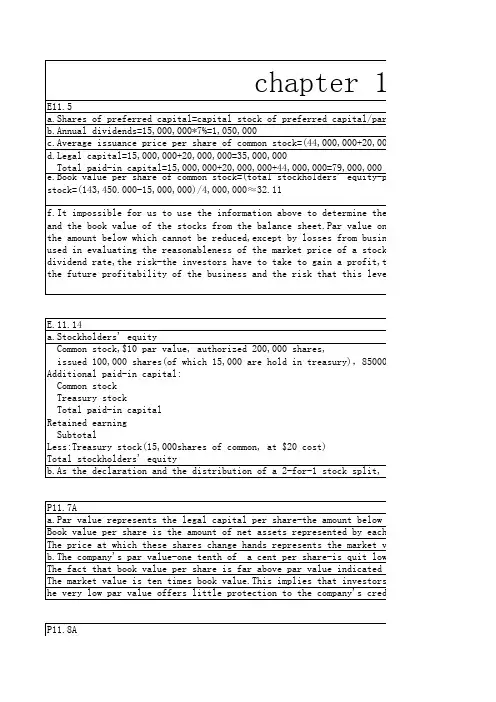
Total paid-in capital=15,000,000+20,000,000+44,000,000=79,000,000 e.Book value per share of common stock=(total stockholders' equity-preferred stock)/shares stock=(143,450.000-15,000,000)/4,000,000≈32.11
会计学基础知识单选题100道及答案解析
会计学基础知识单选题100道及答案解析1. 会计的基本职能是()A. 核算和监督B. 预测和决策C. 监督和分析D. 反映和控制答案:A解析:会计的基本职能包括核算和监督。
2. 企业会计核算应当以()为基础。
A. 收付实现制B. 权责发生制C. 永续盘存制D. 实地盘存制答案:B解析:企业会计核算应当以权责发生制为基础。
3. 下列各项中,不属于资产特征的是()A. 资产是由过去的交易或事项形成的B. 资产是企业拥有或控制的资源C. 资产预期会给企业带来经济利益D. 资产能够可靠地计量答案:D解析:资产能够可靠地计量是资产的确认条件,而非资产的特征。
4. 存货计价采用先进先出法,在物价上涨的情况下,会使()A. 期末存货成本升高,当期利润增加B. 期末存货成本降低,当期利润减少C. 期末存货成本升高,当期利润减少D. 期末存货成本降低,当期利润增加答案:A解析:在物价上涨时,先进先出法会使先购入的存货成本较低先结转,导致期末存货成本升高,当期利润增加。
5. 企业固定资产可以按照其价值和使用情况,确定采用某一方法计提折旧,它所依据的会计核算前提是()A. 会计主体B. 持续经营C. 会计分期D. 货币计量答案:B解析:持续经营假设是企业固定资产选择折旧方法的前提。
6. 下列会计科目中,属于负债类科目的是()A. 预付账款B. 预收账款C. 应收账款D. 应收票据答案:B解析:预收账款是企业预先收取的款项,属于负债类科目。
7. 某企业月初资产总额为300 万元,本月发生下列经济业务:(1)赊购材料10 万元;(2)用银行存款偿还短期借款20 万元;(3)收到购货单位偿还的欠款15 万元存入银行。
月末资产总额为()万元。
A. 290B. 310C. 295D. 305答案:A解析:赊购材料10 万元使资产增加10 万元,偿还短期借款20 万元使资产减少20 万元,收到欠款15 万元存入银行是资产内部一增一减,不影响资产总额。
基础会计学课后题答案
基础会计学课后题答案第一题问题:什么是会计?答案:会计是记录、分类和报告组织的经济交易和事件的过程。
它涉及记录公司的资产、负债、所有权权益、收入和支出等方面的信息。
第二题问题:什么是会计方程?答案:会计方程是会计的基本原理,也被称为财务恒等式。
它是指资产的总额等于负债和所有者权益的总和。
这可以用以下公式表示:资产 = 负债 + 所有者权益这个方程表明组织的财务状况始终是平衡的。
第三题问题:什么是资产?答案:资产是指公司拥有的具有经济价值的物质或无形资产。
它包括现金、应收账款、固定资产等。
资产是企业的资源,可以为企业创造未来的收益。
第四题问题:什么是负债?答案:负债是指公司在未来需要支付的债务或义务。
它包括应付账款、长期负债等。
负债反映了公司对外部实体的债务责任。
第五题问题:什么是所有者权益?答案:所有者权益指的是企业的资本和盈余部分。
它代表了公司对所有者的经济利益。
所有者权益包括企业的股本、保留盈余等。
第六题问题:什么是收入?答案:收入是指企业在经营过程中由出售商品或提供服务而获得的经济利益。
收入可以来自销售商品、出租资产、利息收入等。
第七题问题:什么是费用?答案:费用是指为经营活动而发生的企业支出,可以是现金支付也可以是非现金支付。
费用包括租金、工资、利息等。
第八题问题:什么是利润?答案:利润是指企业在经营过程中从业务活动中获得的净收益。
它可以用来衡量企业的盈利能力和业绩。
利润等于收入减去费用。
第九题问题:什么是现金流量表?答案:现金流量表是一份会计报表,用于反映公司在特定时期内现金流入和流出的情况。
它包括三个主要部分,即经营活动现金流量、投资活动现金流量和筹资活动现金流量。
第十题问题:什么是财务报表?答案:财务报表是会计记录和汇总的结果,用于向利益相关者提供有关组织财务状况和业绩的信息。
常见的财务报表包括资产负债表、利润表、现金流量表等。
以上是对基础会计学课后题的答案,希望对你的学习有所帮助。
会计学 企业决策的基础 第二章
2
BASIC FINANCIAL STATEMENTS
McGraw-Hill/Irwin
© The McGraw-Hill Companies, Inc., 2008
Learning Objective
To explain the nature and general purpose of financial statements.
Assets are economic resources that are owned by the business and are expected to benefit future operations.
McGraw-Hill/Irwin
© The McGraw-Hill Companies, Inc., 2008
© The McGraw-Hill Companies, Inc., 2008
McGraw-Hill/Irwin
Assets
Vagabond Travel Agency Balance Sheet December 31, 2007 Assets Liabilities & Owners' Equity Cash $ 22,500 Liabilities: Notes receivable 10,000 Notes payable $ 41,000 Accounts receivable 60,500 Accounts payable 36,000 Supplies 2,000 Salaries payable 3,000 Land 100,000 Total liabilities $ 80,000 Building 90,000 Owners' Equity: Office equipment 15,000 Capital stock 150,000 Retained earnings 70,000 Total $ 300,000 Total $ 300,000
会计学企业决策的基础财务会计分册英文版第十七版课程设计
Accounting for Business Decision Making - 17thEdition Course DesignCourse OverviewThis course is designed to provide a comprehensive understanding of financial accounting and its role in the decision-making processes of businesses. The course will cover the basic principles of financial accounting and how they are applied to create financial statements to determine the financial health of an organization.Learning OutcomesBy the end of this course, students will be able to:•Understand the basic principles of financial accounting and its role in business decision-making•Analyze and interpret financial statements to gn insights into a company’s financial performance and health•Understand the components of financial statements and how they are interconnected•Understand the factors that influence financial reporting and analysis•Conduct financial analyses to evaluate business performance and make informed decisionsCourse StructureThe course will be divided into the following modules:Module 1: Introduction to Financial AccountingThis module will cover the basic principles of financial accounting, including:•The accounting process•The elements of financial statements•The accounting equation•The double-entry accounting system•The concepts of accruals and deferralsModule 2: Financial StatementsThis module will focus on the components of financial statements, including:•The balance sheet•The income statement•The cash flow statement•The statement of changes in equityModule 3: Financial Statement AnalysisThis module will cover how to analyze the information presented in financial statements to assess a company’s performance, including:•Ratio analysis•Horizontal and vertical analysis•Trend analysis•Common-size financial statementsModule 4: Financial Reporting PracticesThis module will examine the factors that influence financial reporting, including:•Regulatory requirements and standards•Financial reporting ethics•Financial analysis tools and techniquesModule 5: Financial Decision MakingThis module will focus on how financial information is used to make informed business decisions, including:•Capital budgeting•Financing decisions•Investment decisions•Risk managementCourse AssessmentThe course will be assessed through a combination of:•Homework assignments•Quizzes•Mid-term exam•Final examThe final grade for the course will be determined by a weighted average of these assessments.ConclusionThis course provides a comprehensive overview of financial accounting and its role in the decision-making processes of businesses. By the end of the course, students will have a thorough understanding of financial accounting principles and how to apply them to business decision making.。
- 1、下载文档前请自行甄别文档内容的完整性,平台不提供额外的编辑、内容补充、找答案等附加服务。
- 2、"仅部分预览"的文档,不可在线预览部分如存在完整性等问题,可反馈申请退款(可完整预览的文档不适用该条件!)。
- 3、如文档侵犯您的权益,请联系客服反馈,我们会尽快为您处理(人工客服工作时间:9:00-18:30)。
管理会计作业(chapter16-20)Chapter 16 P757 16.5A
Chapter 16 P761 16.4B
Chapter 17 P802 17.3A
a.Department One overhead application rate
based on machine-hours:
Manufacturing Overhead
$420,
000
=$35 per machine-hour
Machine-Hours 12,00 0
Department Two overhead application rate based on direct labor hours:
Manufacturing Overhead
$337,
500
=
$22.50 per direct labor
hour
Direct Labor Hours 15,00 0
Chapter 17 P805 17.8A
d .Th
e Custom Cuts product line is very labor intensive in comparison to the
Basic Chunks product line. Thus, the company’s current practice of using direct labor hours to allocate overhead results in the assignment of a disproportionate amount of total overhead to the Custom Cuts product line. If pricing decisions are set as a fixed percentage above the manufacturing costs assigned to each product, the Custom Cuts product line is overpriced in the marketplace whereas the Basic Chunks product line is currently priced at an artificially low price in the marketplace. This probably explains why sales of Basic Chunks remain strong while sales of Custom Cuts are on the decline.
e .The benefits the company would achieve by implementing an activity-based
costing system include: (1) a better identification of its operating inefficiencies, (2) a better understanding of its overhead cost structure, (3) a better understanding of the resource requirements of each product line, (4) the potential to increase the selling price of Basic Chunks to make it more comparable to competitive brands and possibly do so without having to sacrifice significant market share, and (5) the ability to decrease the selling price of Custom Cuts without having to sacrifice product quality.
Chapter 18 P835 18.1
B. Ex. 18.1
a
.
job costing (each project of a construction company is unique)
b
.
both job and process costing (institutional clients may represent unique jobs)
c
.
job costing (each set of equipment is uniquely designed and manufactured)
d
.
process costing (the dog houses are uniformly manufactured in high volumes)
e
.
process costing (the vitamins and supplements are uniformly manufactured in high volumes)
Chapter 18 P841 18.3A
Inputs:
•Beginning WIP
•Started
Outputs:
•Units completed
•Ending WIP
•Beginning WIP
•Units started
•Units completed
•Ending WIP
•Cost of beginning WIP
•Cost added during the period
•Cost of goods transferred
transferred
•Add ending WIP
$246,000
b4,000 EU @ $13.50 =
$54,000
Chapter 18 P845 18.2B
a .(
1)
$49 [($192,000 + $48,000 + $54,000) ÷ 6,000 units]
(
2)
$109 [($480,000 + $108,000 + $66,000) ÷6,000 units] (
3)
$158 ($49 + $109)
(
4)
$32 ($192,000 ÷ 6,000 units)
(
5)
$18 ($108,000 ÷ 6,000 units)
b .In evaluating the overall efficiency of the Engine Department, management
would look at the monthly per-unit cost incurred by that department, which is the cost of assembling and installing an engine ($109 in part a).
Chapter 20 P918 20.1A
d .No. With a unit sales pric
e o
f $94, the break-even sales volume in units
is 54,000 units:
Unit contribution margin = $94 - $84 variable costs = $10
Break-even sales volume (in units)
$540,000
$10
54,000 units
Unless Thermal Tent has the ability to manufacture 54,000 units (or lower fixed and/or variable costs), setting the unit sales price at $94 will not enable Thermal Tent to break even.
Chapter 20 P918 20.2A
Chapter 20 P920 20.6A
Sales volume required to maintain current operating income:
Sales Volume
Fixed Costs + Target
Operating Income
Unit Contribution Margin
$390,000 + $350,000
= $20,000 units $37。
